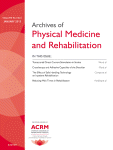
Physical Therapy & Rehab
Limited evidence on the effects of exercise for improvement of age-related hyperkyphosis
This report has been verified
by one or more authors of the
original publication.
Arch Phys Med Rehabil. 2014 Jan;95(1):129-40. doi: 10.1016/j.apmr.2013.06.022.
13 studies were evaluated in this systematic review determining whether exercise can improve kyphotic angle in adults at least 45 year old or older with preexisting hyperkyphosis. Measures of kyphosis or forward head posture were investigated, although meta-analysis was not performed due to heterogeneity in intervention techniques. 2 RCTs found significant differences between groups, favouring exercise aimed at increasing back extensor muscle strength to treat hyperkyphosis, whereas other studies reported no significant differences or only within-group differences. Overall, evidence was found to be sparse and lacking standardized clinical outcome measures. Further studies will be necessary in order to conclude on the effects of exercise on hyperkyphosis.
Unlock the full article
Get unlimited access to OrthoEvidence with a free trial
Start TrialCritical appraisals of the latest, high-impact randomized controlled trials and systematic reviews in orthopaedics
Access to OrthoEvidence podcast content, including collaborations with the Journal of Bone and Joint Surgery, interviews with internationally recognized surgeons, and roundtable discussions on orthopaedic news and topics
Subscription to The Pulse, a twice-weekly evidence-based newsletter designed to help you make better clinical decisions
Exclusive access to original content articles, including in-house systematic reviews, and articles on health research methods and hot orthopaedic topics
Or continue reading this full article
Register Now

Subscribe to "The Pulse"
Evidence-Based Orthopaedics direct to your inbox.





































